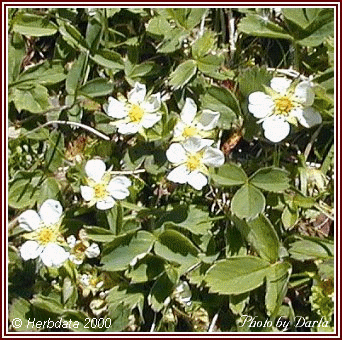
 FRAGARIA
VESCA. L.
FRAGARIA
VESCA. L.
Var., americana,
Porter
Compiled and edited by Ivor
Hughes
Common names: English strawberry, Alpine strawberry, Wood strawberry.
Nat. Ord. Rosaceae.
Botanical Source. Strawberry is a perennial. plant, with a creeping, knotty root. The stems are trailing, with stolons often creeping several feet. The leaves are pubescent and trifoliate; The leaves are pubescent and trifoliate; the radical ones on long foot-stalks; the leaflets obovate-wedge form, coarsely serrate, and subsessile; the stipules lanceolate-oblong, cohering with the base of the petiole. The flowers, borne on scapes, are white, one or several; the peduncles are erect or nodding.
History and Chemical Composition. This is a European species, presenting exhaustless varieties, which are extensively cultivated, flowering from April to May, and ripening its fruit in May and June. The F. Virginiana, Ehrhart, or wild strawberry; F. canadensis, or mountain strawberry; F. grandiflora, or pine-apple strawberry, and the other varieties possess similar properties. The fruit of all the varieties is highly fragrant and delicious, the cultivated varieties frequently being very large. The fruit contains about equal parts of citric and malic acids, sugar, mucilage, pectin, water, peculiar volatile aroma, woody fiber, and pericarps. The root contains a glucosid called fragariamarin, not easily soluble in water, alcohol, or ether. Upon hydrolysis with acids it splits into sugar and fragarin, a red amorphous substance (C. E. Sohn, Dictionary of Active Principles of Plants, 1894).
Action, Medical Uses, and Dosage. The fruit, used very freely, has been highly spoken of in calculous disorders, likewise in gout, and the juice will dissolve the hard concretion called "tartar," which forms on the teeth, and without injuring them. With some, strawberries disagree, causing disordered digestion, and frequently a rash-like eruption on the surface. The grains or seed-like pericarps are indigestible, and sometimes cause irritation of the bowels. Strawberry-juice, or the syrup, added to water, forms a refreshing and useful drink for febrile patients; care being taken that the grains are removed by filtering or expressing the juice or syrup through a piece of muslin. Strawberries eaten with cream are, as a rule, injurious to dyspeptics. The leaves are slightly astringent, and have been used , in infusion, in diarrhoea, dysentery, and intestinal debility; the roots are diuretic, and have been beneficially used, in infusion, in dysuria, gonorrhea, etc. The leaves of the wild strawberry, gathered after the ripening of. the fruit, and dried in the sun, or in heated pans, afford a greenish and slightly astringent infusion, like that of the Chinese tea, with similar diaphoretic, diuretic, and excitant properties.
Abstracted and abridged from :
King's American Dispensatory.
by Harvey Wickes Felter, M.D., and John Uri Lloyd, Phr. M., Ph. D., 1898
If you did not find what you were seeking, use the site search box at the top right hand of the page or browse the site library and images.
![]()